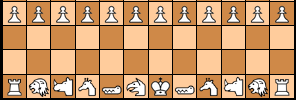Comments/Ratings for a Single Item
I have recently recalculated the piece values in this game. And finally gave Ralph Betza due credit for inventing the Spotted Gryphon. Unlike me, Fergus managed to read all of Ralph's bent rider theory without falling asleep. Caïssa Britannia, invented by Fergus Duniho in 2003, contains the Dragon (Alfilrider + Dabbabarider). But what about the squares that are skipped over? On [2021-02-24] Fergus Duniho wrote a Comment (worth quoting here) to Bent Riders by Ralph Betza.
"Last night I was thinking of bent riders that are not bent in the sense of changing direction. I suppose they are among the 25 possibilities Betza mentions, but I don't think he elaborated on them. One piece I was thinking of would initially move as a Wazir, then if it continues, continue as a Dabbabbah-Rider. Unlike the Dabbabbah-Rider, this would not be color-bound. Another one would initially move as a Ferz, then if it continues, continue as an Alfil-Rider. Unlike the Alfil-Rider, this would be able to reach every space of the same color instead of just half of them. I was thinking I might call these the Shifty Rook and the Shifty Bishop and their compound the Shifty Queen. Has anyone used these pieces before?"
Ah yes, I see, it is a halfling Rose indeed!
 H. G. Muller wrote on Sun, May 23, 2021 09:40 PM UTC in reply to Jörg Knappen from 09:21 PM:
H. G. Muller wrote on Sun, May 23, 2021 09:40 PM UTC in reply to Jörg Knappen from 09:21 PM:Nice to see the Spotted Gryphon in this diagram, it is another difficult piece to describe!
Indeed. Before I had introduced the paretheses notation, it would have been necessary to mention every distance separately, with a large number of intermediate steps.
I understood from the article that in this variant the Rose only has 4 steps.
Shouldn't the Rose have the move qN8 (including a zero move if the full circle is available) instead of just qN4? In the starting position after
- k4-k5 ... it should be possible to play 2. Of2-f6.
Nice to see the Spotted Gryphon in this diagram, it is another difficult piece to describe!
 H. G. Muller wrote on Sun, May 23, 2021 08:30 PM UTC:
H. G. Muller wrote on Sun, May 23, 2021 08:30 PM UTC:Rose Chess XII
Innovative choice of pieces. Theoretically they fit well with each other. But game play turnsout to be rather awkward.
7 comments displayed
Permalink to the exact comments currently displayed.

In the terminology of All the King's Men the 'degenerate' bent riders that double their stride after the first step are called slip pieces. (While the normal riders with a two-square stride are called skip pieces, and those that half their stride ski pieces.) So the Spotted Gryphon would be a Slip Griffon.